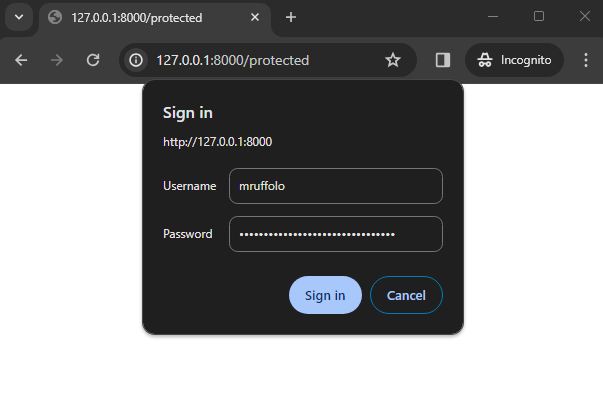**Please consider this project to see domain controller auth using sessions and sqlite db with a professional login page
https://github.com/RetributionByRevenue/fastapi-sessions-domaincontroler



-
LDAP_AUTH Function:
- The
LDAP_AUTHfunction takes three parameters:domain,username, andpassword. - Inside the function, a connection to the LDAP server is established using the provided domain, username, and password.
- The
Connectionobject attempts to bind (authenticate) using the provided credentials. - If the bind is successful (
conn.result['result'] == 0), the function setsdidConnecttoTrueand prints an authentication success message. - If an exception occurs during the authentication attempt, it prints an authentication failure message.
- Finally, the connection is closed (
conn.unbind()).
- The
-
FastAPI Application Setup:
- A FastAPI instance (
app) is created. - The
HTTPBasicclass fromfastapi.securityis used to define Basic Authentication, and an instance namedsecurityis created. - The
check_ldap_authfunction is defined as a FastAPI dependency. It takesHTTPBasicCredentialsas a parameter, which represents the username and password extracted from the request headers. - Inside
check_ldap_auth, theLDAP_AUTHfunction is called with the provided domain, username (from credentials), and password (from credentials). - If the LDAP authentication fails, a
HTTPExceptionwith a 401 status code and "Invalid credentials" detail is raised. - If authentication succeeds, the username is returned.
- A FastAPI instance (
-
Protected Route:
- An example protected route
/protectedis defined. - The
check_ldap_authdependency is used to ensure that only authenticated users can access the route. - If authentication is successful, a message is returned, indicating that the user has access to the protected route.
- An example protected route
-
Running the Application:
- When you run the FastAPI application and access the
/protectedroute in a browser or a tool like Swagger UI, a pop-up window appears for you to input the username and password. - The entered credentials are then passed to the
check_ldap_authfunction, which, in turn, calls theLDAP_AUTHfunction for LDAP authentication.
- When you run the FastAPI application and access the
-
Note on Domain Credentials:
- The domain credentials (in this case, the LDAP server domain, username, and password) are hardcoded within the
LDAP_AUTHfunction. In a real-world scenario, you might want to externalize and secure these credentials, potentially using environment variables, configuration files, or a secure credential management system.
- The domain credentials (in this case, the LDAP server domain, username, and password) are hardcoded within the
Overall, this setup demonstrates how to integrate LDAP authentication with FastAPI, leveraging Basic Authentication for user credential input and LDAP for authentication against an LDAP server.